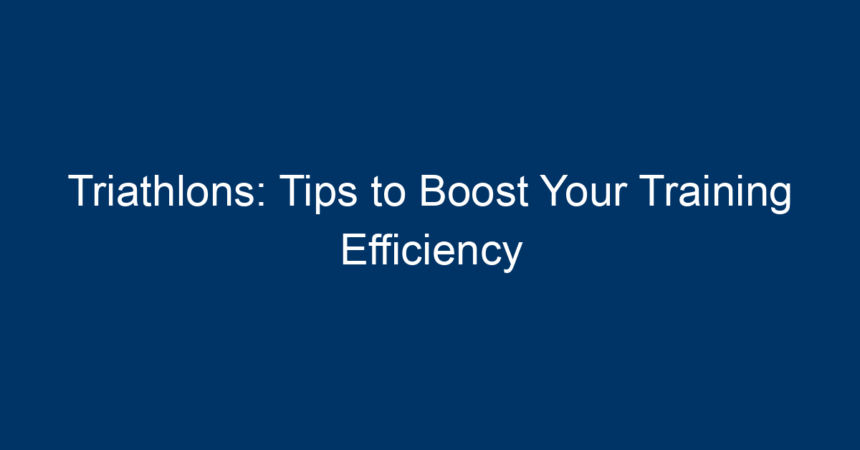Triathlons are more than just a test of endurance; they are a celebration of physical strength and mental resilience. With the sport’s rising popularity, athletes of all levels are eager to improve their training efficiency. Whether you’re a seasoned triathlete or just starting your journey, honing your training methods can enhance performance and elevate the enjoyment of competing in triathlons. In this article, we’ll explore actionable tips to help you maximize your training efficiency, improve your skills, and achieve your personal best in triathlons.
Understanding the Triathlon Structure
Before diving into training tips, it’s essential to understand the triathlon structure. A typical triathlon consists of three disciplines: swimming, cycling, and running. Racing through each leg requires a unique set of skills and techniques, making it imperative to craft a well-rounded training strategy.
The Swim Segment
The swim is often the first leg of a triathlon, and for many, it can be the most daunting. To improve your swimming efficiency:
-
Technique over Distance: Focus on perfecting your swim technique rather than solely increasing your distance. Work with a coach or join a swim clinic to refine your strokes.
-
Include Drills: Incorporate specific swimming drills into your routine, such as catch-up stroke, fingertip drag, and sculling. These build strength and efficiency.
- Open Water Practice: If your triathlon includes open water swimming, practice in like conditions. This helps acclimate to sighting and dealing with waves and currents.
The Cycling Segment
Cycling is vital in triathlons, often comprising the longest segment. Your bike training can be more effective with these tips:
-
Interval Training: Incorporate interval training sessions to build speed and endurance. Alternate between high-intensity bursts and recovery periods.
-
Long Rides: Schedule long rides at least once a week to enhance endurance. Aim to ride for distances comparable to your triathlon event.
- Bike Fit: A proper bike fit is crucial to avoid injuries and improve your power transfer. Consult a professional to get adjusted to your specific needs.
The Run Segment
The final leg of a triathlon can be a mental and physical challenge. Here’s how to optimize your run training:
-
Brick Workouts: Practice brick workouts, which involve transitioning from cycling to running. This prepares your body for the unique fatigue experienced during a triathlon.
-
Pace Variability: Train at different paces. Incorporate tempo runs, intervals, and long steady runs to build a versatile running skill set.
- Strength Training: Include strength workouts focusing on your legs, core, and stabilizing muscles. Bodyweight exercises, resistance training, and plyometrics can significantly enhance your running efficiency.
Nutrition: The Fuel for Your Training
No triathlon training plan is complete without proper nutrition. What you eat can greatly impact your energy levels and performance.
Pre-Training Nutrition
Before workouts, consume easily digestible carbs, such as bananas or oatmeal. Swapping large meals for lighter snacks can help avoid sluggishness during training sessions.
During Exercise Hydration
Staying hydrated is crucial, especially during long workouts. Consider electrolyte drinks during rides or runs lasting more than an hour to maintain optimal performance.
Post-Training Recovery
After training, replenishing your body with proteins and carbs is vital for recovery. Timing matters; aim to eat within 30 minutes of finishing your workout to boost muscle recovery.
Recovery: The Unsung Hero of Training
Many athletes overlook the importance of recovery. Efficient training needs rest and recovery periods to ensure peak performance.
Sleep is Non-Negotiable
Adequate sleep is vital to recover fully and maintain optimal hormone levels. Aim for 7-9 hours of quality sleep every night, especially after intense training.
Active Recovery Days
Incorporate active recovery days featuring low-intensity activities like yoga, swimming, or cycling leisurely. This approach promotes blood flow and aids muscle recovery without excessive strain.
Cross-Training Benefits
Engaging in cross-training can mitigate burnout and reduce the risk of injuries. Activities like hiking, swimming, or even strength training can provide physical variety while maintaining fitness.
Mental Training: Strengthening Focus and Resilience
Training for triathlons is as much a mental endeavor as it is physical. Building mental toughness can enhance your overall performance on race day.
Visualization Techniques
Visualizing your race can help reduce anxiety and boost confidence. Picture yourself executing each leg of the triathlon, from the swim start to crossing the finish line.
Set Small Goals
Setting manageable, incremental goals can keep you focused and motivated throughout your training. Celebrate small victories to maintain your passion for triathlons.
Embrace Mindfulness
Mindfulness techniques, such as meditation and breathing exercises, can help you stay centered during stressful training sessions or competitions. Practicing mindfulness can improve your focus and endurance.
Equipment: Finding the Right Gear
Having the right equipment can drastically affect your training efficiency. Ensure you have quality gear suited to your specific needs.
Swim Gear
Invest in a good-quality wetsuit if your triathlon requires it. Additionally, ensure you have the right goggles that fit comfortably and provide clear visibility.
Bike Quality
Choosing the right bike is crucial. Whether you opt for a road bike or a triathlon-specific model, make sure it’s fitted properly. Regular maintenance will also help prevent mechanical issues during training and races.
Running Shoes
Select running shoes tailored to your foot type and gait. Consider visiting a specialty running store for gait analysis to find your ideal fit.
Conclusion: Actionable Insights for Triathletes
Training efficiently for triathlons is essential for success and enjoyment in the sport. By focusing on improving techniques, incorporating effective nutrition, prioritizing recovery, strengthening mental resilience, and investing in appropriate gear, you can boost your training efficiency significantly.
Remember, triathlons are about the journey as much as the destination. Embrace the process, listen to your body, and continually seek improvement. With dedication and the right strategies, you’ll be better prepared and more confident on race day. So gear up, stay motivated, and make your next triathlon experience your best one yet!
By implementing these tips, you’ll not only optimize your training but also build a foundation for long-term success in the world of triathlons. Let’s get training!




